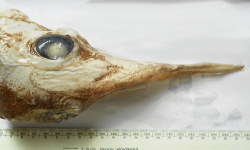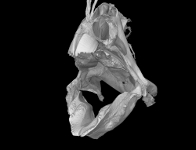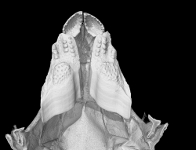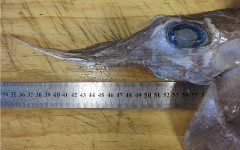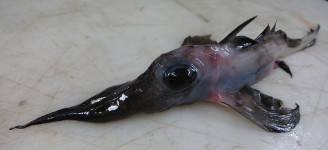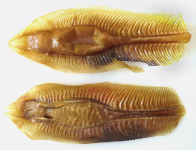Harriotta raleighana
Goode & Bean, 1895
Narrownose chimaera
Classification: Holocephali Chimaeriformes Rhinochimaeridae
Reference of the original description
On Harriotta, a new type of chimaeroid fish from the deeper waters of the northwestern Atlantic. Proceedings of the United States National Museum, 17(1014), 471–473
On Harriotta, a new type of chimaeroid fish from the deeper waters of the northwestern Atlantic. Proceedings of the United States National Museum, 17(1014), 471–473
Image of the original description
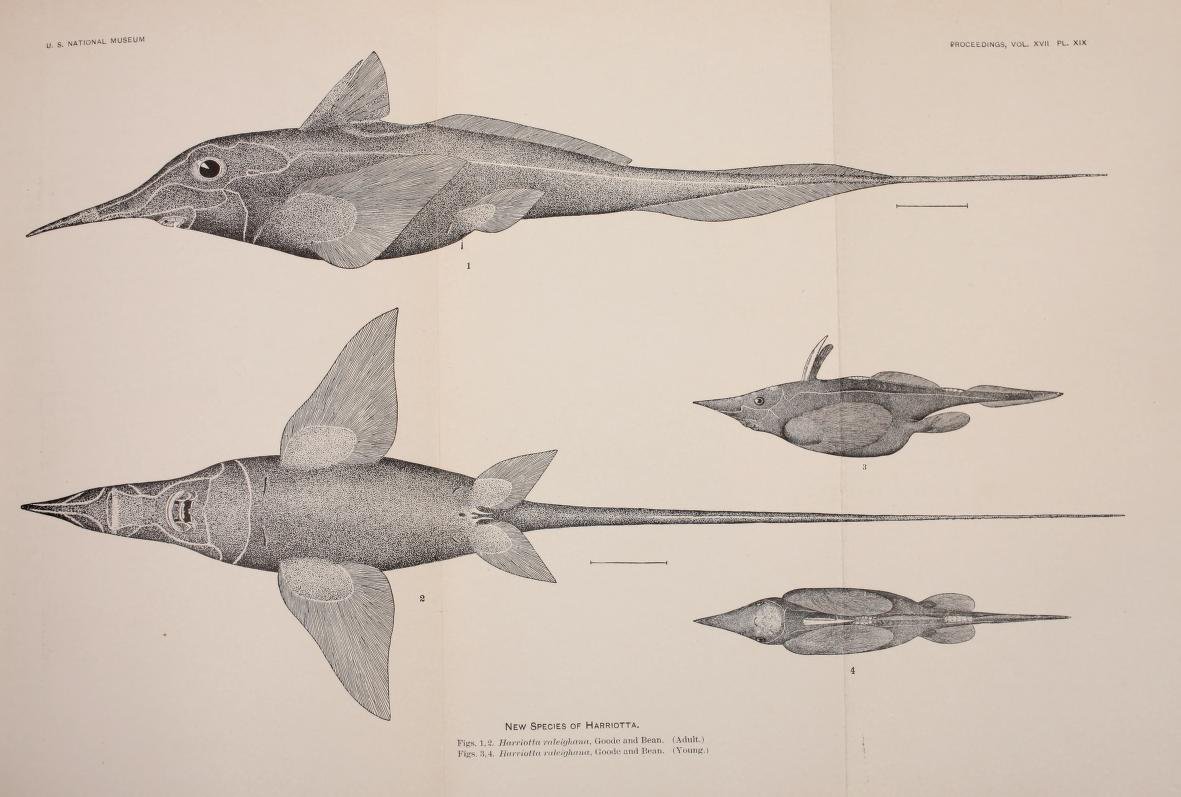
Harriotta raleighana Goode & Bean, 1895

Harriotta raleighana Goode & Bean, 1895
Synonyms / new combinations and misspellings
Harriotta cf. raleighana, Harriotta curtissjamesi, Harriotta opisthoptera, Harriotta raleighiana
Harriotta cf. raleighana, Harriotta curtissjamesi, Harriotta opisthoptera, Harriotta raleighiana
Types
Harriotta raleighana
Lectotype: USNM: 35520 Paralectotype: USNM: 35631 USNM: 38200 USNM: 39415
Harriotta curtissjamesi
Holotype: USNM: 87552 (old: AMNH 8342)
Harriotta opisthoptera
Holotype: ECSFI: SH80D-0411; Paratype: ECSFI: SH80D-0404; ECSFI: SH80D-0326; ECSFI: SH80D-0329; ECSFI: SH80D-0391; ECSFI: SH80D-0402; ECSFI: SH80D-0410;
Harriotta raleighana
Lectotype: USNM: 35520 Paralectotype: USNM: 35631 USNM: 38200 USNM: 39415
Harriotta curtissjamesi
Holotype: USNM: 87552 (old: AMNH 8342)
Harriotta opisthoptera
Holotype: ECSFI: SH80D-0411; Paratype: ECSFI: SH80D-0404; ECSFI: SH80D-0326; ECSFI: SH80D-0329; ECSFI: SH80D-0391; ECSFI: SH80D-0402; ECSFI: SH80D-0410;
Description :
Citation: Harriotta raleighana Goode & Bean, 1895: In: Database of modern sharks, rays and chimaeras, www.shark-references.com, World Wide Web electronic publication, Version 01/2026
Please send your images of "Harriotta raleighana" to info@shark-references.com

Harriotta raleighana Goode & Bean, 1895, adult, female © Brit Finucci

Harriotta raleighana Goode & Bean, 1895, adult, female © Brit Finucci
Common names
 Gewöhnliche Langnasenchimäre,
Gewöhnliche Langnasenchimäre,  Langnasenchimäre,
Langnasenchimäre,  Peje rata,
Peje rata,  Quimera de Raleigh,
Quimera de Raleigh,  Quimera picuda,
Quimera picuda,  Quimera picuda del Pacífico,
Quimera picuda del Pacífico,  Tucán,
Tucán,  Chimère bécune du Pacifique,
Chimère bécune du Pacifique,  Chimère de Raleigh,
Chimère de Raleigh,  Chimère spatule,
Chimère spatule,  Chimère à nez rigide,
Chimère à nez rigide,  Bentnose rabbitfish,
Bentnose rabbitfish,  Bigspine spookfish,
Bigspine spookfish,  Chimaera,
Chimaera,  Long-nosed chimaera,
Long-nosed chimaera,  Longnose chimaera,
Longnose chimaera,  Longnose spookefish,
Longnose spookefish,  Longnosed chimaera,
Longnosed chimaera,  Narrownose chimaera,
Narrownose chimaera,  Pacific longnose chimaera,
Pacific longnose chimaera,  Rat fish,
Rat fish,  Ratfish,
Ratfish,  Spookfish
Spookfish
 Gewöhnliche Langnasenchimäre,
Gewöhnliche Langnasenchimäre,  Langnasenchimäre,
Langnasenchimäre,  Peje rata,
Peje rata,  Quimera de Raleigh,
Quimera de Raleigh,  Quimera picuda,
Quimera picuda,  Quimera picuda del Pacífico,
Quimera picuda del Pacífico,  Tucán,
Tucán,  Chimère bécune du Pacifique,
Chimère bécune du Pacifique,  Chimère de Raleigh,
Chimère de Raleigh,  Chimère spatule,
Chimère spatule,  Chimère à nez rigide,
Chimère à nez rigide,  Bentnose rabbitfish,
Bentnose rabbitfish,  Bigspine spookfish,
Bigspine spookfish,  Chimaera,
Chimaera,  Long-nosed chimaera,
Long-nosed chimaera,  Longnose chimaera,
Longnose chimaera,  Longnose spookefish,
Longnose spookefish,  Longnosed chimaera,
Longnosed chimaera,  Narrownose chimaera,
Narrownose chimaera,  Pacific longnose chimaera,
Pacific longnose chimaera,  Rat fish,
Rat fish,  Ratfish,
Ratfish,  Spookfish
Spookfish
Short Description
A longnose chimaera with a rather long, narrow, depressed snout, a small eye situated above or behind the mouth, a rather long first dorsal fin and spine, knobby tooth plates, and caudal fin lanceolate with no tubercles on upper edge but with a long terminal filament (Ref. 5578, 6871, 41248). Dark brown or blackish in color [536]. No separate anal fin. Claspers are rod like, rather slender, unbranched, with tip somewhat swollen. Jugular and oral canals arising separately from orbital, with a short interspace; angular (maxillary) canal joining suborbital about 2/7 of distance from front level of eye toward tip of snout (Ref. 41248).
A longnose chimaera with a rather long, narrow, depressed snout, a small eye situated above or behind the mouth, a rather long first dorsal fin and spine, knobby tooth plates, and caudal fin lanceolate with no tubercles on upper edge but with a long terminal filament (Ref. 5578, 6871, 41248). Dark brown or blackish in color [536]. No separate anal fin. Claspers are rod like, rather slender, unbranched, with tip somewhat swollen. Jugular and oral canals arising separately from orbital, with a short interspace; angular (maxillary) canal joining suborbital about 2/7 of distance from front level of eye toward tip of snout (Ref. 41248).
Distribution
Eastern Atlantic: Iceland, Faeroe Islands, Rockall Trough along Ireland to northern France; Canary Islands and off Cap Blanc, Mauritania; Namibia and South Africa [536]. Western Atlantic: Nova Scotia, Canada to Chesapeake Bay in USA; southern Brazil. North Pacific: off Japan and California, USA; also 100 km off southern Baja California. South Pacific: off New Zealand and Australia (Ref. 7300). Source: www.gbif.org
Eastern Atlantic: Iceland, Faeroe Islands, Rockall Trough along Ireland to northern France; Canary Islands and off Cap Blanc, Mauritania; Namibia and South Africa [536]. Western Atlantic: Nova Scotia, Canada to Chesapeake Bay in USA; southern Brazil. North Pacific: off Japan and California, USA; also 100 km off southern Baja California. South Pacific: off New Zealand and Australia (Ref. 7300). Source: www.gbif.org
Human uses
fisheries: of no interest
fisheries: of no interest
Biology
Oviparous, young hatch at about 10-13 cm [578]. Found on the continental slope and ocean floor. Benthopelagic, occurs 600-2150 m depth (Ref. 58744). Appears to feed mainly on shellfish and crustaceans.
Oviparous, young hatch at about 10-13 cm [578]. Found on the continental slope and ocean floor. Benthopelagic, occurs 600-2150 m depth (Ref. 58744). Appears to feed mainly on shellfish and crustaceans.
Remarks
shark-references Species-ID=2644;
shark-references Species-ID=2644;
Parasites (arranged by Jürgen Pollerspöck)
Cestoda
Cestoda
- Gyrocotyle haffii Bray, Waeschenbach, Littlewood, Halvorsen & Olson, 2020 [28528]








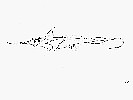
.jpg)
